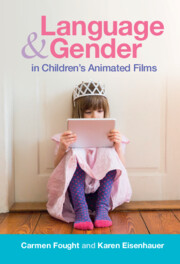Book contents
- Language and Gender in Children’s Animated Films
- Language and Gender in Children’s Animated Films
- Copyright page
- Dedication
- Contents
- Figures
- Tables
- Preface
- Acknowledgments
- 1 Introduction
- 2 Gender, Disney, and Pixar in Historical Context
- 3 Representation, Speech Amounts, and Talkativeness
- 4 Compliments
- 5 Directives
- 6 Insults
- 7 Apologies
- 8 Representing Queerness
- 9 Conclusion
- References and Filmography
- Index
7 - Apologies
Published online by Cambridge University Press: 01 September 2022
- Language and Gender in Children’s Animated Films
- Language and Gender in Children’s Animated Films
- Copyright page
- Dedication
- Contents
- Figures
- Tables
- Preface
- Acknowledgments
- 1 Introduction
- 2 Gender, Disney, and Pixar in Historical Context
- 3 Representation, Speech Amounts, and Talkativeness
- 4 Compliments
- 5 Directives
- 6 Insults
- 7 Apologies
- 8 Representing Queerness
- 9 Conclusion
- References and Filmography
- Index
Summary
This chapter focuses on apologies, another active, face-saving politeness strategy. Apologies are a way of conducting politeness and preserving interpersonal relationships. There is a clear perception that women apologize more, or apologize unnecessarily, and this chapter examines if that is reflected in Disney and Pixar films. Quantitatively, both male and female characters apologize in these films, and in a certain proportion of the cases the authors suspect this is determined more by the specifics of the plot than by gender or any other characteristic of the speaker. At the same time, the authors find some patterning at the extremes that seems more clearly linked to gender. While apologizing may not be marked as specifically associated with femininity, non-apology strategies do seem to be mostly used by the male characters. One explanation for this is that women have been held more responsible for maintaining social relations and catering to the face needs of others. Femininity may be tied to a focus on making sure the social harm is repaired, while masculinity involves more of an emphasis on producing the speech act of the apology while (if possible) hedging against the inherent face threat it involves.
Keywords
- Type
- Chapter
- Information
- Language and Gender in Children's Animated FilmsExploring Disney and Pixar, pp. 155 - 172Publisher: Cambridge University PressPrint publication year: 2022

